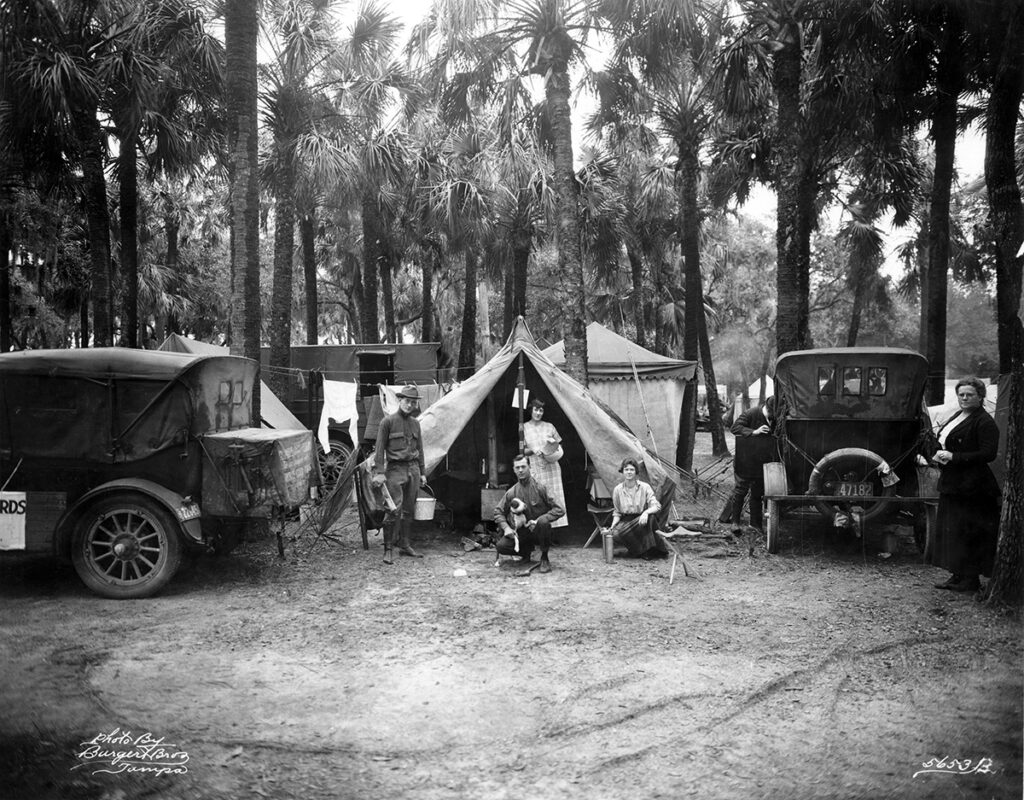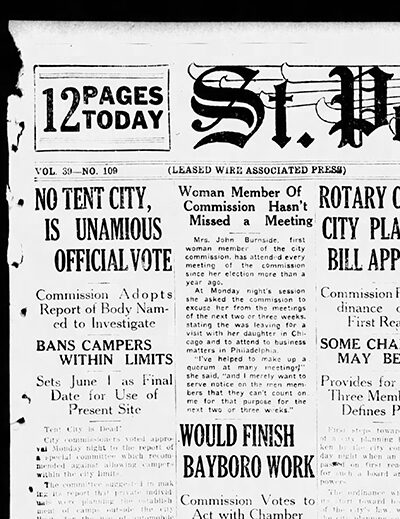The first automobile rolled into St. Pete in 1905, but unpaved city streets, virtually nonexistent county roads, and insufficient bridge crossings kept many people from jumping on board. As the decade unfolded, attitudes changed. By 1920, over 8 million cars had been registered in the United States; by the end of the decade that number had tripled. Trains and trolleys were still in the lead, but automobiles clearly were the future. Citizens and city leaders alike led the quest for more and better roads and bridges. Bond issues were approved, and millions of dollars were spent to pave, construct, and extend roadways and bridges linking the barrier islands and spanning Tampa Bay. Locals celebrated the relative new ease in navigating Florida, as did the growing number of tourists choosing to take road trips south.

Tourists Take to the Road
In addition to a growing network of roadways, America’s new love affair with the car gave birth to travel-centered businesses like motels and roadside diners. Despite their best efforts, however, these businesses could not always keep pace with the needs of road trippers. Camping became a popular alternative for many car-driving vacationers. They may have paved the way for today’s RV enthusiasts, although their experiences were considerably more rustic. Most people could boast no more than their car, a few cooking utensils, and maybe a canvas tent or awning for protection. Most roads were still unpaved, and many were no more than muddy or dusty paths. Cars were unreliable and prone to breakdowns and busted wheels. Public campgrounds also were virtually nonexistent. Instead, drivers would simply stop along the public roadside for the night or request permission to spend the night on private property. The sometimes-harsh realities of road travel led many travelers to try and band together into “touring parties” for support and camaraderie. In 1919, a group of these car-touring travelers banded together at a Tampa campground to organize the Tin Can Tourists of the World (TCT). They wanted to unite automobile campers, promote camp cleanliness, and provide “wholesome entertainment.” The origin of the term “tin can” is not clear. Perhaps it referred to the canned foods the campers relied on. It may have been connected to the car that many TCT members drove, the Ford Model T, or “Tin Lizzie.” Regardless, the organization was just one indicator of the growing popularity of automobile camping in Florida.

A “Tent City” in the Sunshine City
Across the bay, the Sunshine City also felt the effect of this new trend. In August 1920, the early arrival of two automobile “touring parties” inspired St. Petersburg mayor Noel Mitchell to prepare a plan of action. According to his proposal, the municipal campgrounds at 18th Street and Second Avenue S would be converted into a “Tent City” to accommodate the anticipated growing number of automobile tourists. Plans for the community included staking the grounds so the tents could be placed in a “street formation,” adding street lights, and placing signs along Central Avenue to direct new arrivals to the Tent City. As city officials discussed plans, new campers kept popping up “like mushrooms.” By mid-November, more than 450 campers from all across the nation had registered at the free camp site, and the numbers kept growing. As the season progressed and more campers arrived, the ideas expanded to include building an enclosed clubhouse with a fireplace, free laundry facilities, a grocery store, and a library. In reality, it was “practically impossible for the city to keep up with its growth” as it struggled to build sufficient basic “comfort stations” for sanitation. Meanwhile, more substantial renovations were stalled by opposition. Concerns about crime, safety, sanitation, costs, and the city’s image rose as the number of campers increased. By the time Tent City closed for the season in April, over 2,000 campers had made it their home for a night or the entire season. Its popularity was undeniable. Plans for Tent City’s future flourished among the campers. There was even talk of establishing a miniature form of “home rule” government within the camp’s ground.

“Tent City is Dead!”
On May 10, 1921, city commissioners voted unanimously to ban campers from within city limits. They cited local complaints and concerns about a variety of issues. “Tent City is Dead!” the St. Petersburg Times noted. The dream of a municipal tent city was gone, but its demise didn’t end the demand. The number of registered visitors to the Sunshine City rose steadily each season in the 1920s. Hotels were quickly rising, but even when hotel rooms were available, some visitors chose to rent from private camping venues like Leora Lewis’ Tent City near Lake Maggiore and Miller’s Tent City. Touring the country in a car had changed the way that many people traveled. No longer bound to the rail, they could set their own pace. Car travel evoked the idea of freedom and spawned a new definition of American independence. Despite its quick origination and equally speedy demise, St. Petersburg’s Municipal Tent City offers a snapshot of how the rise of the automobile changed America.
Sources available on request.



